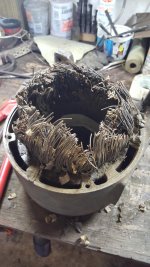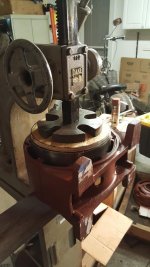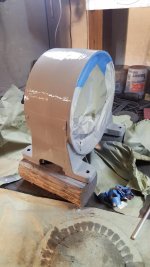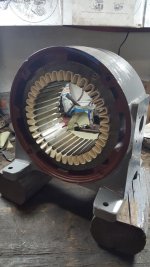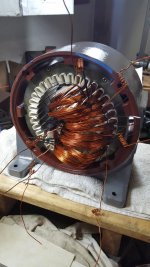Clownshoes
Aluminum
- Joined
- Apr 22, 2009
- Location
- NC, USA


Background: Near the end of a lathe rebuild project I had been working on I had to make a decision about what to do with the motor it came with. It worked when I got it but like everything else was not in any kind of condition to be used with any type of confidence. The motor appeared contemporary to the lathe (though I'm fairly sure it is not the original) so my natural inclination was to reuse it but I was not certain what that would entail. I contacted some local businesses to see about having it done professionally and no one would quote me a price without seeing it in person but I was not keen on lugging a dirty 100Lb motor around town simply for an estimate. I started researching online what it took to rewind a 3-phase motor and had quite a bit of trouble finding any information in english. The majority of information was coming from indian or thai sources who seem to have a lot more interest in motors than we do in the states. Of the information I was able to find none were identical to the motor at hand but I began to piece together the general process. I contemplated purchasing a new motor but could not get over the poor aesthetics of them and was dismayed to learn that vintage motors in good condition aren't readily available since a number have gone the way of the scrap yard for the copper inside. Once I felt confident I knew what I was getting into I decided to go at it on my own and I wanted to share the process I went through in hopes of saving more vintage motors from the scrap pile. I want to mention I am a mechanical engineer, not electrical, so I can't say much about how the motor actually works (oddly enough my EE friends couldn't either) I just know what the guts are and how it all goes together.
Step 1: Motor Specs
Easy stuff - 3 phase, 3 HP, 220/440V, 60Hz
Not so easy stuff - 16 AWG windings, 24 turns/coil, 36 coils, 12 coil groups, double layer winding.
The double layer winding was important as all the videos I had seen were of single layer wound stators, this I had to completely figure out from the original windings and made very little sense at first but once I got it, it was pretty straight forward. Basically every stator slot is occupied by two sides from different coil groups.

In order to begin I peeled back the wrapping and cut one coil on the non-terminal end of the stator. If you can do this with one single cut it helps deducing the amount of wire needed later on. Everything will be caked in varnish and if it's old like mine it crumbles apart pretty easily. From here you can determine the gauge of wire and number of turns and this last part was somewhat confusing. The number of wires you count here ends up being N+1, where N is the number of turns/coil. This didn't make sense until I started winding small samples of wire as a mock-up and I can't really explain it any further than that. At this point I still have no idea how many coil groups I have or how many coils per groups there are or what direction everything is wound.
Step 2: Terminal Connections
Flipping the motor around to the terminal side, I placed a piece of masking tape around the inside of the stator and numbered each slot. I labeled the slot where T1 exited as slot "1" and went from there, this is for reference only but was very helpful in figuring out the winding pattern. Here I recorded every slot that had a terminal exiting from it and where it went, whether it was an internal connection or one of the nine terminals that exit the motor. Here you can also confirm your coil span which is very important, in this case it was "7" which means if you counted over 7 slots from the side of any one coil you would find the other side and since it is double layer it would be opposite the slot position of where you started (top or bottom).
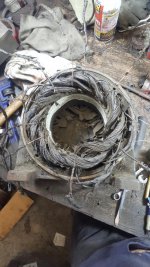
Step 3: Wiring Diagram
Once all the terminal and slot location information was recorded it was time to create a diagram. If you look online most everyone will write out the slot numbers in a linear fashion and draw in the coils as a diamond or some other shape but I found this very confusing and could not keep track of where everything was being connected so I drew my own similar to what I was actually seeing. At first I only had the terminal location information and was not certain how all the loops connected or interacted with one another but once I had it drawn out and started looking closely at the standard "Y" diagram for 3-phase motors, things began making sense and I was able to determine that I had 12 coil groups with 3 coils/group, and playing around with some mockups I determined everything was wound clockwise in order to lay down properly in the slots.



